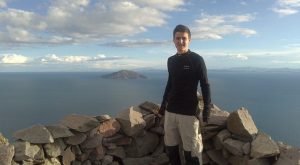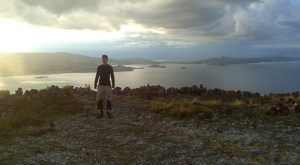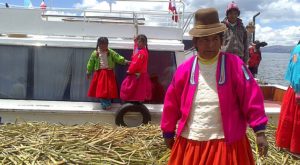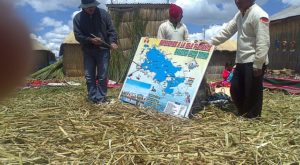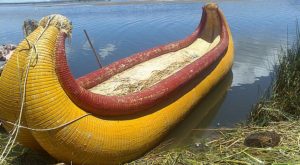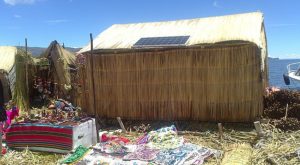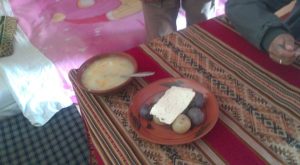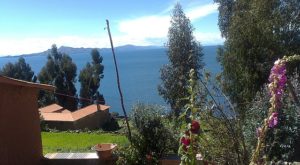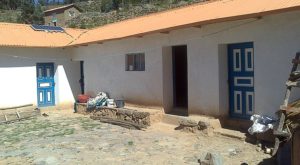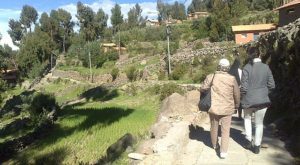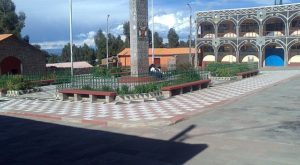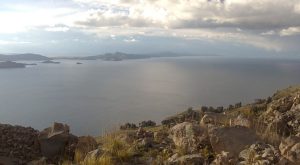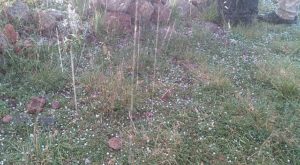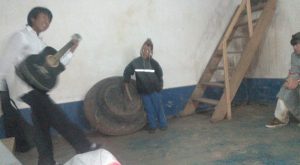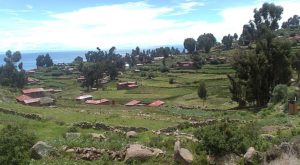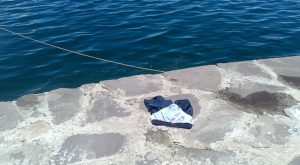Lake Titicaca is the highest lake in the world, so I was surprised someone had brought a paintball gun with them.
At least that’s what it felt like on top of Amantani before I realised it was hail stones pelting down from the sky. The sun was still setting (allowing some picturesque snaps) so it was all the more confusing.
Once our group came out from shelter (some old stone structures) we made the 40 minute walk back to the town’s Central Plaza to meet up again with our host families.
The day began taking a 2 hour boat ride from the Puno port to a floating island in the middle of the Lake. Still a bit unsure what Lake Titicaca was all about, our guide, Lucho, gave us a breakdown of things we should know.
I’ll translate into LT Fun Facts:
LT Fun Fact #1: The Lake sits at over 4,000 metres above sea level and is the highest in the world
LT Fun Fact #2: Its diameter stretches over 150km and there are many inhabited islands on it
LT Fun Fact #3: 60% is Peruvian, 40% is Bolivian
LT Fun Fact #4: It is thought of as “the cradle of Peru” as people have been living on it for millennia
LT Fun Fact #5: ‘True’ locals have very dark blood (high altitude, more haemoglobin). It is/was thought to give them superhuman strength
LT Fun Fact #6: Some families live on floating islands made of reeds, named Uros
LT Fun Fact #7: There used to be more, but the introduction of rainbow trout to the Lake in the 1940s destroyed ecosystem, moving people to land
LT Fun Fact #8: The reeds are used for animal feed with mainlanders, in exchange for the bright clothing
LT Fun Fact #9: The bigger, main islands have no police. Instead people live by Inca Commandments (be nice, don’t steal, don’t be a fool)
After taking a tour of the floating islands, myself and another guy hopped on one of the handmade reed boats and were guided around it.
The Lake was only 8 metres deep there (it can reach up to 200), so our gondola experience was all the more Venicion – being propelled by a long stick.
From here we continued our journey (this time by motor) to Amantani where we were introduced to our host families for the night.
Along with two Peruvian ladies (the only non-English speakers on the tour), I walked with Laudia (our ‘mama’) back to her house on the hillside.
Amantani is 10km squared, has 10 villages and around 4,000 inhabitants. Many, like Laudia, were born on the island.
Lunch was quinoa soup, and potatoes with cheese, eaten in one of the outhouses.
I then dropped my bags in another before we set off to reconvene in the central plaza (town square), a ten minute walk away.
After some more information about the island and the beliefs on solar movements (a common theme amongst the pre-Spanish civilisations) we began a hike to the highest point of Amantani for sunset.
It really was beautiful.
There were peninsulas, snow capped mountains, and islands rearing their heads out of the blue tranquility.
Despite being pretty inaccessible, almost every inch up there was used for crops.
Fields were divided by stacked up rocks, and there were some more robust structures (old temples, we were told).
The scene was set: culturally significant location, idyllic sunset, a few photos for the DPP ‘Maybe’ pile; this was surely a perfect time to Find Myself…
And then the paintballing began.
Any profound/ world-changing views I may have been formulating were quickly extinguished (or rather popped) by the high-velocity stones hailing from above.
Taking cover lasted about half an hour, by which time the sky had turned into an array of blue which made the descent that much more pleasant.
Dinner was had back at the ranch, and we then returned to the central plaza for a spot of “Peruvian dancing” with an “authentic Peruvian band”
In reality it was the hokey-kokey in ponchos to one man playing the guitar and a boy with a drum and a stick.
Nevertheless it was fun enough, and on the pouring walk home I learnt just how surprisingly waterproof the heavy ponchos could be.
In the morning we said our Goodbyes to the families and hopped on the boat to a second ‘proper’ island, Taquile
This used to be a type of Alcatraz in the time of the Spanish settlement, and today the community is still very old fashioned.
Husband and wife are never seen walking together (she is always a number of steps behind), and weaving is a primary skill taught young – UNESCO recognised it as an important part of the cultural heritage that needed to be protected.
To prove himself to a woman, a Taquilean man will weave a hat, and if it holds water for a couple of minutes (i.e. well knit) he has the necessary qualities. He has displayed his ‘boyfriend material’, so to speak…
After this it was another walk through the terraced farms (and pop up stores selling Gatorade and Mars Bars) to the boat on the other side of the island.
Here I took up the opportunity to go for a swim in the “refreshing” waters (the mountain rivers run into the Lake). #yolo
A three hour boat ride later and we were back on mainland.
The community life brought back memories of Belize (see 6.3.1 & 6.3.2), however the setting and talk of islands reminded me more of ‘Lost’.
The Lake is yet another example of new ideas compromising age-old traditions in local cultures.
Of course the natural response is that the way of life should be preserved and protected against Western influence. However with that comes women as second-class citizens and an apathy to new ideas.
So I have yet to form my conclusion on the matter.
What could have been if it didn’t start hailing…
